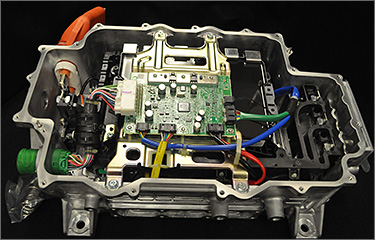Electric-Drive Vehicle Thermal Performance Benchmarking

NREL thermal performance benchmarking of state-of-the-art power electronics and electric
motors helps guide future R&D efforts as well as industry product-development efforts.
Photo by Scot Waye, NREL
NREL's thermal performance benchmarking research focuses on state-of-the-art technologies used in electric-drive vehicle (EDV) systems. Benchmarks are shared with industry so that systems can be improved and the cost, size, and weight of automotive power electronics and electric motors can be reduced.
State-of-the-art power electronics and electric motor thermal management strategies used in non-automotive applications may also be benchmarked.
NREL's benchmarking research characterizes the performance of the thermal management system for power electronics and electric motors. Enhancement features are being identified and evaluated to better understand their effect on performance. NREL evaluates various cooling strategies to understand which heat exchangers are most effective in terms of thermal performance and efficiency. The intent is to provide industry with information that can be used to understand the state of the art and achieve the aggressive performance and cost targets for EDVs.
The objectives of NREL's benchmarking studies are as follows:
-
Characterize the thermal resistance and conductivity of various layers in the stackup (for both power electronics and motors)
-
Measure the pressure drop in the heat exchanger(s) at various flow rates
-
Find the thermal resistance (junction-to-coolant) of the stackups at different flow rates
-
Perform flow visualization in some portions of the heat exchangers using high-speed photography and particle imaging velocimetry.
Share
